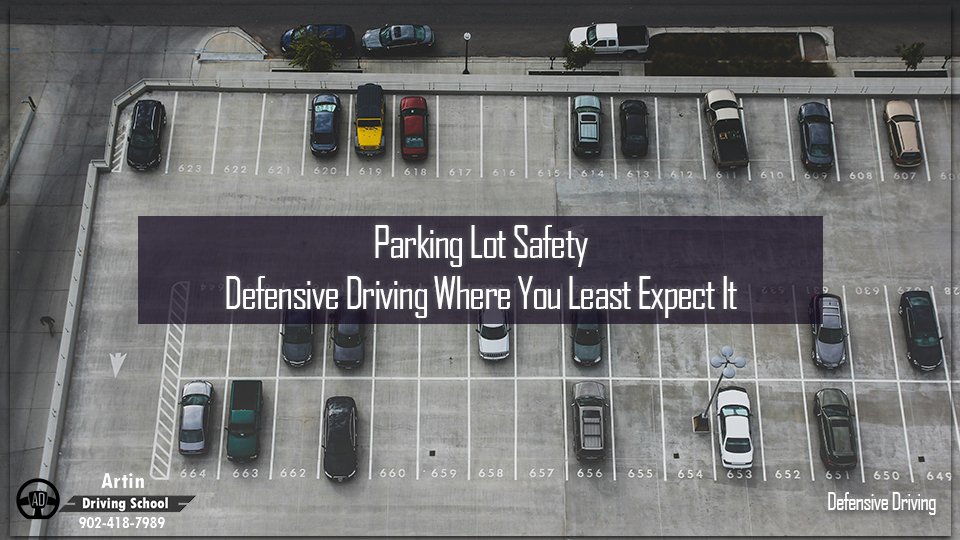We spend our highway drives on high alert, but the moment we pull into a parking lot, our defensive driving mindset often switches off. This is a critical mistake. While the speeds are low, these environments are chaotic and unpredictable. Learning and applying specific parking lot safety tips is a key part of being a true defensive driver, protecting you from dents, dings, and dangerous close calls.
Think about the parking lot at the Halifax Shopping Centre on a Saturday or Mic Mac Mall during the holidays. It’s a flurry of activity: cars reversing, pedestrians appearing from between vehicles, shopping carts rolling free, and drivers competing for limited spots. According to safety experts, tens of thousands of collisions happen in parking lots and garages every year. It’s time to treat these spaces with the same respect and attention we give the open road.
On This Page:
1. Control Your Speed: The Golden Rule
The single most important parking lot safety tip is to keep your speed down. It’s tempting to rush toward what looks like an open spot, but a slow and steady pace is your absolute best defense against the unexpected.
Why it Matters More Than You Think
Reduced speed gives you more time to react. A small child, hidden by the hood of a large SUV, could suddenly chase a ball into the lane. A driver, focused on their phone, could swing their door open without looking. Driving at a walking pace, around 5-10 km/h, doesn’t just give you more time to brake, it dramatically reduces your stopping distance. This is the difference between a close call and a tragic incident.
2. Scan Constantly and Expect the Unexpected
A parking lot is not a place to relax, check your phone, or plan your shopping list. Your head should be on a swivel, actively scanning your entire environment. This is the core of defensive driving in a low-speed, high-hazard zone.
What to Actively Look For
- Reversing Lights: The moment you see white reverse lights illuminate on a parked car, assume it is about to move. Don’t assume the driver has seen you. Try to make eye contact, but be prepared to stop.
- People Walking to Their Cars: A person with keys in hand is a future hazard. They are about to get in their car, start it, and likely back out. Give them space and be ready for them to move.
- Moving Feet and Shopping Carts: Look for feet moving between parked cars. This is often the first sign of a pedestrian about to emerge into your path. Be equally cautious of runaway shopping carts, especially on windy days.
- Open Doors and Trunks: Watch for drivers or passengers opening their doors or loading groceries into their trunk. Give all parked cars a wide berth to avoid a collision or a tense exchange.
3. Master the Reversal: The Back-In Advantage
A huge percentage of parking lot collisions happen while backing out of a parking spot. Your visibility is limited, you’re focused on multiple directions, and you’re trying to merge into a lane with other moving vehicles.
How to Back In Safely
While it takes more effort upfront, backing into a parking spot is generally safer because it allows you to pull out forward with a full, unobstructed view. To do it right:
- Signal your intention.
- Pull your vehicle just past the empty spot.
- Check your mirrors and blind spots thoroughly.
- Slowly reverse, turning the wheel to guide your car into the space. Use your mirrors and backup camera, but don’t rely on them alone.
If you must back out, turn down your radio, put away distractions, and creep out at a snail’s pace. Be ready to stop instantly.
4. Use Space Like a Pro
Where you park and how you position your car can significantly reduce your risk. This is a proactive strategy that good defensive drivers use to avoid trouble before it starts.
Choose Your Spot Wisely
Don’t just circle endlessly looking for the closest spot to the entrance. These are high-traffic, high-risk areas. Consider parking a little further away where it’s less congested. This reduces the number of cars and people you have to interact with. If possible, choose an end spot to minimize the risk of dings from one side. Better yet, find two empty spots you can pull straight through, so you can exit without reversing at all.
5. Communicate in a Low-Rule Environment
Parking lots often lack clear rules of the road. Who has the right-of-way between a main thoroughfare and a smaller feeder lane? It’s often ambiguous. This is where communication becomes a critical safety tool.
- Use Your Signals: Signal your intention to turn into a parking lane or a specific spot. It alerts drivers behind you and prevents them from trying to whip around you.
- Make Eye Contact: This is the best way to ensure other drivers and pedestrians see you. A simple nod or wave confirms you’ve established mutual awareness.
- Be Patient and Courteous: Sometimes, two drivers arrive at a spot at the same time. A simple hand gesture yielding the spot can prevent a frustrating standoff or an aggressive reaction. A little courtesy goes a long way in improving parking lot safety for everyone.
This focus on safety isn’t just about preventing dents. As the National Safety Council (NSC) points out, parking lots are a prime location for crashes caused by distraction. Applying these parking lot safety tips helps you avoid becoming a statistic.
The skills you use to stay safe on the highway—observation, anticipation, communication, and control—are the same ones you need in a parking lot. They are all part of a complete defensive driving mindset.
Ready to sharpen the skills that protect you everywhere you drive? Take a certified course at Artin Driving School.
The information provided on this post is for general informational purposes only and is not intended to serve as professional advice or guidance. While Artin Driving School strives to ensure the accuracy and timeliness of the information shared, Artin Driving School makes no guarantees, warranties, or representations regarding the completeness, reliability, or suitability of any content posted.






What i do not realize is actually how you’re not actually much more well-preferred than you might be right now. You’re so intelligent. You know thus considerably relating to this subject, made me personally consider it from so many varied angles. Its like men and women are not involved except it?¦s one thing to do with Girl gaga! Your own stuffs excellent. At all times care for it up!